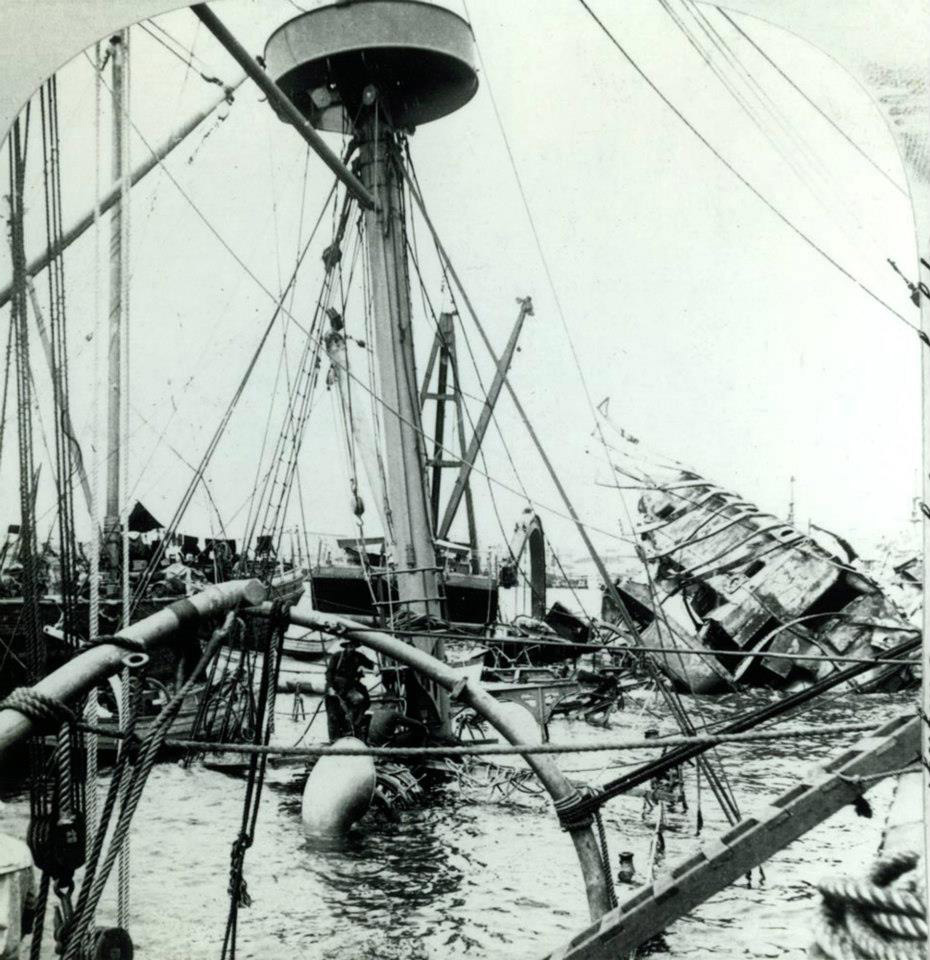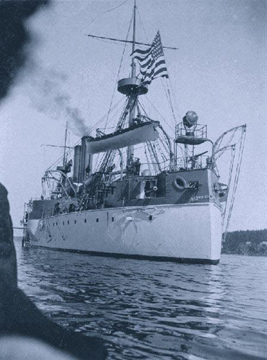Spencerport and the Spanish American War, part 2

by Virginia Parker,
Village of Spencerport Historian
President McKinley and the USS Maine
On March 4, 1897, William McKinley became the 25th president of the United States. The conflict in Cuba was now his concern. He wanted to keep America out of it and worked at a diplomatic solution. He urged Americans to contribute to a Cuban relief fund and asked Congress to give Spain time to change. He made little progress.
In January 1898, Spanish supporters in Havana felt betrayed and rioted. President McKinley sent the battleship USS Maine to Havana. The Maine, completely designed and built in America, was the newest and most sophisticated ship of the fleet. Her destination was announced only 24 hours in advance of her arrival as a safety precaution.
Remember The Maine
Diplomacy was failing. On February 9, 1898, the New York Journal printed a private dispatch by the Spanish Ambassador. The diplomat insulted McKinley and hinted that Spain wasn’t willing to give up what they had possessed for over 350 years. The result was a political stalemate. Americans became even more anti Span.
On February 15, 1898, at 9:40 p.m. as the men aboard the USS Maine were falling asleep, the pride of the American Navy exploded in Havana Harbor.
The bow was torn apart as her munitions exploded. Only the aft mast, standing above the waves, marked the spot where The Maine had sat so proud. Spain proclaimed its innocence. The cause of the explosion was a mystery. The captain of The Maine survived and felt it was an accident. Of the 350 sailors and officers aboard, 266 died.
The investigations began. It took a month to gather all the testimony and inspection reports. Divers reported a large crater under the sunken wreck.
President McKinley was worried. The American military force had shrunk following our Civil War. Spain outnumbered us. On March 8, 1898, President McKinley requested a $50 million military appropriations bill. The bill passed.
On March 21, 1898, The U.S. Naval Court of Inquiry found that the loss of The Maine was not the fault or negligence of her officers or sailors. It was the court’s opinion that The Maine was destroyed by the explosion of an underwater mine, which then caused the detonation of her ammunition magazines. The Court didn’t have evidence to place the blame for the destruction of The Maine on anyone.
The public only heard “destroyed by the explosion of an underwater mine.” The emotions that were building for three long years now boiled over and things started to move quickly. Europe, even the Pope, tried to relieve the situation.
McKinley was now at the end of his diplomatic rope; he demanded that Spain release Cuba and leave. Then, he ordered the U.S. Atlantic fleet to blockade Cuban ports. Both countries declared war.
On April 23, 1898, President McKinley called for 125,000 men for a volunteer army. The men of the National Guard, already armed and equipped, stepped forward to serve their country. Nineteen of Spencerport’s sons answered the call. Here are their stories.
202nd NY Volunteer Infantry
As per General Order No. 8 on June 27, 1898, the 202nd NY Volunteer Infantry was organized in Buffalo at the National Guard Armory. Recruiting began on July 10. Within two weeks, eight of our young men had enlisted as privates into Co’s B, C, and L. By August 1, the entire regiment was gathered at Camp Black, Long Island. On August 12, 1898, the fighting in Cuba ended, but there was still work to be done. The men were stationed in Pennsylvania and Georgia before shipping out. They landed in Havana on December 9 and set up headquarters in Guanajay. Their job was to rebuild Cuba. In February, the first cases of yellow fever among the troops were reported. The Army took precautions and moved the base. The new headquarters had no fresh water. It was brought in from three miles away. In March, orders were received sending them home. On April 15, 1899, nine months after enlisting, they were discharged in Savannah, Georgia. In Spencerport, the April 18 evening train, carrying Spencerport’s heroes, was greeted by the whole village. Seven of our soldiers were whisked off to the Congregational Church for a celebration dinner including music and six toasts.
William Martin Truesdale (1878–1967) – Co. B
His parents were James T. Truesdale and Mary A. Hayner. At the time of the Spanish American War, James was President (Mayor) of Spencerport. Will had four sisters and one brother. He was 19 years old when he enlisted. On February 7, 1899, he was promoted to Corporal. He married Eva Thompson on September 5, 1905. They lived in Buffalo where he operated a wholesale banana business. Sometime after 1920 he began working for the Buffalo and Niagara Power Company. They had a son, Robert. Will was a cancer survivor. In September 1947, he co-organized the “Cut Throat Club” to help others like himself who, because of cancer surgery, had lost the ability to speak. William communicated with a device. He was 90 years old when he died. He is buried in Forest Lawn Cemetery in Buffalo.
Harry John Durkin (1879–1962) – Co. B
His parents were John M. Durkin and Ella Frances Brown. John was a Rochester Policeman; E. Frances was an artist. They ended their marriage when Harry was about 14 years old. Harry had two sisters. He was 18 years old and working as a meat cutter in Ogden when he enlisted. Harry was ill when the 202 left for Cuba. He joined them there on December 23 as part of the Signal Corps. After his service, he worked as a salesman and made his way to Texas. On March 3, 1907, he married Rose Blumenthal in Palestine, Texas. They had two children. From Texas they moved to Chicago. Harry was 82 years old when he died. He is buried in Oakwood Cemetery in Chicago.
Henry John Lesker, Jr. (1874–1967) – Co. C
Henry was the only son of Henry Lesker Sr. and Anna Hess. The family moved to Spencerport sometime before 1892. He had four sisters and is the great uncle of Spencerport’s current Mayor, Gary Penders. Henry Sr. worked as a stone mason. Henry Jr. was 23 years old when he enlisted. After his service, he worked as a day laborer. Henry never married. He moved to Livonia before settling in Medina. In 1931, he spent six months in the home for disabled Veterans in Bath, NY. He was 93 years old when he passed away. Henry is buried in the Boxwood Cemetery in Medina.
Martin T. Moden (1877–1916) – Co. B
Martin was born in Kensington, England, to Phoebe (Barrett) Moden, a widow, and William. He had a half-brother from his mother’s first husband and two half-sisters from her second. He came to the U.S. before 1892. Martin was 21 years old when he enlisted. After his service, he worked as a carpenter. On November 24, 1903, he married Josephine, sister of his brother-in-arms Henry Lesker. They had no children. Martin died at 39 years old after a brief illness. He was laid to rest in Fairfield Cemetery, Spencerport.
Alfred Ballard Tubb (1880–1954) – Co. B
Alfred was born in Manchester, England, to William H. Tubb, Sr. and Rebecca Ballard. He had four sisters and three brothers. The family came to Spencerport around 1889. Alfred was 17 years old when he enlisted. From August 3, 1898, to October 17, 1898, he was in the Army Band. After his service, he was a musician with the Parks Band. He lived in Perinton with Emory and Lizzie Lapham. The Laphams, their five children and Alfred moved to Florida where Alfred continued to be a musician. Lizzie was widowed in 1926. Alfred and Lizzie were married in 1930 and returned to Monroe County shortly thereafter. Lizzie died in 1937. Alfred married a second time in 1946 to Olga (Craver) Frind. Alfred never had children. He was 74 when he died at home from a sudden heart attack. He was laid to rest in Fairfield Cemetery with his parents.
Arthur Samuel (Thrasher) Lourett (1875–1942) – Co. L
Arthur was born in Adams Basin. His father most likely died before he was four. His mother, “Clara” (Mosher) Thrasher remarried around 1879. Her second husband, Amos Lourett, raised Arthur like his own. Arthur had a half-brother and a half-sister. He was 22 when he enlisted. About 1902, he married Annie Leisch or Linton and moved to Niagara Falls, where he worked in a paper factory. They had two boys and a girl. In 1915, their house burned; everyone escaped, but Annie was badly burned. Annie died in 1917 after a short illness. In 1918, Arthur remarried. May, his second wife, died in 1926. In 1928, the court ruled his 16-year-old daughter was “incorrigible” and sent her to the reformatory in Albion. From there she went to the Newark State Hospital. Arthur moved to Bergen, lived with his cousin, Frances, and worked as a farmer. He was 67 years old when, at the doctor’s office, he passed away from heart disease. He was laid to rest in Locust Grove Cemetery.
Arthur Miles Tuttle (1872–1952) – Co. B
Arthur was seven and his youngest sister an infant when their mother moved them to Spencerport after a tragic house fire took the lives of his father and a toddler sister. He was 25 years old when he enlisted. After the service, he returned to Spencerport and worked in a greenhouse. Arthur never married. By 1930, he was unable to work. He was 79 years old when he passed away and was laid to rest in Fairfield Cemetery, Spencerport
James Oscar Curtis (1880–1968) – Co. B
His parents were Seymour H. Curtis and “Nellie” Gott. Seymour owned the land that is now Pineway Ponds Park. James had one sister. He was 17 years old when he enlisted. On August 4, 1898, he was transferred to the band for one month before he transferred back to Co. B. He was discharged without honor on September 27, 1898, from Camp Meade, Pennsylvania, after only 10 weeks in the Army. He returned to Spencerport, where, about 1902, he married Minnie P. Upton. They had two children. Sometime before 1921 he began working for Kodak. James was 87 years old when he died. He was laid to rest in Fairfield Cemetery, Spencerport.

Next Time the 3rd NY Vol. Infantry, Spencerport’s Sailor, and the War in the Philippine




